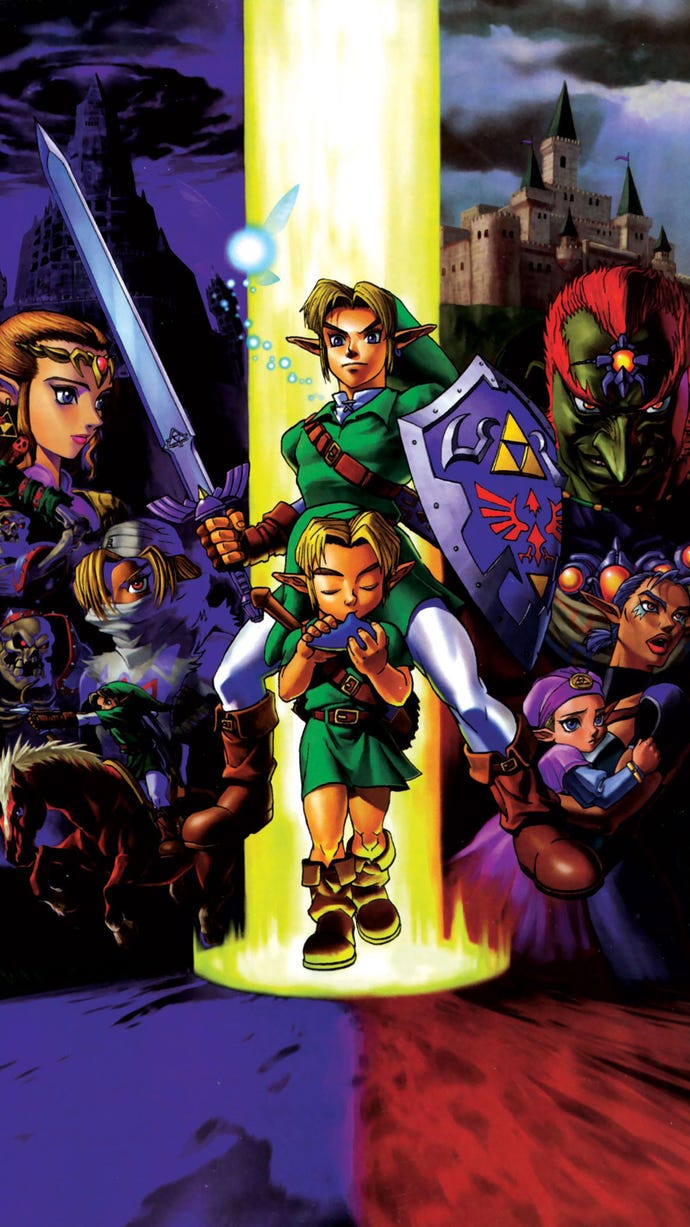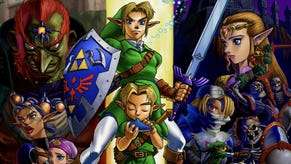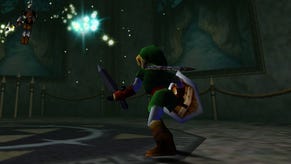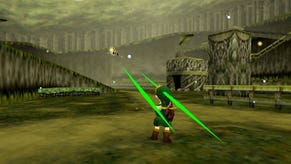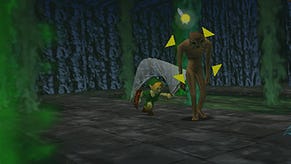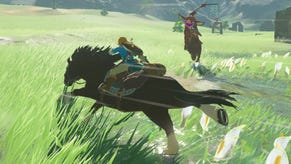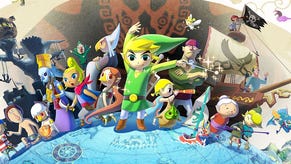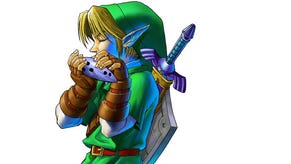Mind-melting highlights from the latest Zelda: Ocarina of Time beta leak
Things we obsessed over in the early internet of the nineties are now real.
Nintendo may not exactly approve, and in some cases the means of acquisition have been illegal, but it’s been a banner couple of years for fans curious about the creation of some of gaming’s most iconic games. The latest revelation is in many ways a holy grail: a 1997 build of The Legend of Zelda: Ocarina of Time. Remember, the game didn’t come out for a year after that.
The story of how this build came to be found is a long one, but the short version is this: gaming preservation fans found an N64 development cartridge of classic Nintendo racer F-Zero X. However, the F-Zero demo was seemingly written over the top of a 1997 build of Zelda - and with careful tinkering, sleuths have been able to extract the leftover data. This means the 1997 build isn’t playable - but in this context, that hardly matters.
What the build gives us instead is a glimpse at a very different Ocarina of Time. It’s difficult to articulate exactly what it was like to those who weren’t there, but the run-up to its release was, well, wild. It was a game that was in magazines for years, and publicly morphed and changed form several times - something not that common back then.
After launch, fans couldn’t let that go, especially after OOT turned out to be one of the greatest ever made. They obsessed online over beta screenshots, over snippets of video showing Link obtaining the triforce, and over endless rumors and famous photoshopped screenshots of the Temple of Light. This morphed from an obsession over hidden secrets to one over cut content, using those old screenshots as a guide.
Deciphering and puzzling out what every unidentified element of the game back then has been a work of the two decades since, but this most recent find has revealed more than any other. Indeed, many of the mysteries are now beginning to be fully solved. People on social media and the excellent The Cutting Room Floor, a website dedicated to cut game content, are having a field day.
Not everybody has the time or inclination to trawl a thousand tweets and forum posts to see what’s been discovered, so I thought I’d summarize some of the key findings.
Landmines, Reed Whistles, and Beta Designs
One of the most interesting elements of this leak at a glance is the item menu. We can’t see the actual menu running, but all of the assets and icons that would’ve appeared in it are intact - so we can see early versions of items we know, or cut alternatives.
For instance, there’s a spiky blue shell type item that lines up with text references to a ‘Landmine’; a static bomb that can be placed that explodes when an enemy touches it. There’s zero mention of the robotic ‘Bombchu’ bombs in this build, however, so it seems likely that the static landmine evolved into the more dynamic bombchu.
There’s also a Reed Whistle item, present here in equipment menu icons. We know from magazine previews that this was used to summon Link’s horse Epona before a now-iconic Ocarina song took over that function. The idea would be revisited; in the GameCube’s Twilight Princess, Link uses reeds to whistle and summon Epona.
There’s also obvious beta designs. The Hookshot as of this build looks far more similar to its Zelda: A Link to the Past version. The hover boots have little wings attached to the back of them - which makes them visually line up with the Pegasus boots, a 2D Zelda staple.
A very different Ocarina
In the item iconography from this build, there’s no early-game Fairy Ocarina - only the Ocarina of Time, which is typically received a few hours in. More interesting, however, is that the entire Ocarina setup appears to be a little different.
Menu icons only exist for six songs - there are twelve in the final game, not including the Scarecrow’s Song. Some of these cuts are even explained by other things in the build - Epona’s Song would be irrelevant with the existence of the Reed Whistle, and text in the build about using inns to switch between night and day quickly would suggest The Sun’s Song was a later addition.
However, it also appears that the three reward items for the ‘Child’ era dungeons were at one point Ocarina related - in the beta iconography, they’re shaped like musical notation, taking the forms of the Sharp, Flat, and Natural. Did you slot these into the Ocarina to unlock more abilities?
Dungeon Elements & Arrows
In the final game, we have Light, Fire, and Ice Arrows - elemental add-ons for the bow with pretty obvious effects. However, it seems at this point in development there were a whole lot more elemental arrows.
Icons show the Yellow, Red and Blue arrows that correspond to Light, Fire, and Ice, but also Silver, Black, and Green arrows. These colours of course line up to the dungeons, matching up to the Spirit, Shadow and Forest medallions. What powers could these arrows have bestowed?
Something we’ve known about for a while regarding Ocarina of Time is that the theming of dungeons changed during development, but much in this data supports that fact. The water temple medallion looks like a snowflake even in the final game, indicating that it was once more ice-focused. Similar evidence points to the Forest Temple once being a Wind Temple, something later revisited in Wind Waker. Ocarina’s Ganon’s Tower trials back this up, too - in the final game, the Forest trial is wind-themed and the water trial ice-themed. This isn’t a surprise and has been surmised for a while, but it’s good to see elements of this build confirm the theory.
Medallions, Magic, and Playing as Navi
This one is a little nuts, but here goes: at one point, you could play as Navi, Link’s Fairy. Sorta.
This one comes down to a combination of data from the menu icons, unearthed script data, and things we already knew. Nineties screenshots showed Link with the dungeon Medallions, received for completing each dungeon, equipped as items, something impossible in the final game. The medallions appear in the item data set here, backing that up. But, all new for this build, is text relating to the function of these medallions when equipped.
Specifically, it appears Ocarina of Time was to have a more fully-featured magic system - and each medallion would unlock a magic spell. Some of these were clearly repurposed into the three magic spells in the final game. Din’s Fire, for instance, was almost certainly the Fire Medallion spell. Beta text shows the ‘Wind Medal’ - which as detailed above was from what became the Forest Temple - would’ve been a warp spell, which became Farore’s Wind in the final game.
But other spells are new. The medallion acquisition text in this beta suggests that the Shadow one could make you invisible to enemies - a skill later offered by the Stone Mask in Majora’s Mask.
The one people are getting excited about, however, is the soul/spirit medallion. It seems this one would’ve let you become Navi, flying around the world as Link’s fairy friend. This is particularly fascinating as this wouldn’t have been a new Zelda feature at this point - in Zelda 2: Adventure of Link, one of the key magic spells lets Link take control of a fairy to reach otherwise impossible areas. In later 3D Zelda games, Link would get skills allowing control of some birds.
It’s interesting to think about what this would’ve been used for. There’s little evidence of the magic beans or the Scarecrow’s song in this build’s data, so perhaps it was used to reach higher-up locations as those are in the final game? Either way - playable Navi!
Story Tweaks & Notes
Buried in this build is an early pass at a bunch of the game’s script at this stage. While in Japanese, fans are hard at work translating the most interesting elements. Here’s some highlights:
- Mido the Sage: multiple script lines point to Mido, the moody Kokori from the game’s opening, being the original Shadow Temple Sage. In the final game, that’s Impa’s job. This actually rather lines up, as every sage in Ocarina of Time is named after a town from Zelda 2 - except Impa. Y’know who is named after a Zelda 2 town, though? Mido.
- Every Town Seemingly had an Inn: a staple of RPGs, the script has lines for Link checking in to the Zora Hotel, or the Castle Town Inn. The dialogue suggests these inns are used to change the in-game clock, even with prompts for Link to select an exact time to get his wake-up call. As previously mentioned, this suggests that at this stage, the time-altering Sun’s Song for the Ocarina didn’t exist.
- Hebra Mountain & Death Mountain: in A Link to the Past, the mountain at the top of Hyrule has two different names. In the Light World, it’s Hebra Mountain. In the Dark World, it’s Death Mountain. In Ocarina, the huge volcano is simply called Death Mountain - but a line in this script notes that its actual name is Hebra, and the Death thing is just a nickname. In Breath of the Wild, Hebra is a separate mountain entirely on the other side of Hyrule.
- The Role of the Gods: in this beta version of the script, the involvement of the Zelda universe’s three goddesses - Din, Naryu, and Farore - is far more explicit. In the Gerudo Desert, there’s a statue that in the west is known as ‘The Desert Colossus’. In Japanese, that’s simply called the ‘Giant Evil God Statue’. However, in this build, it has a slightly longer name: ‘Statue of the Evil Goddess Din’. So, seemingly, the Gerudo worshipped Din - whose piece of the Triforce ended up with Ganondorf. Furthermore, in Zelda’s exposition dump chat with Link in the Castle Courtyard, she specifically calls her prophetic dreams messages from the goddess Naryu. It seems at some point, these gods were more explicitly part of the story.
Beta Locations & Maps
I’ve sort of saved the best bit for last - which is that this build contains loads of recoverable beta map data. These beta maps vary from slightly different to complete do-overs. For instance, Kakariko Village has a much more flat and basic layout more reminiscent of A Link to the Past. It was clearly entirely restarted; it doesn’t even have a Windmill. But the design of Death Mountain is largely the same - only missing detail, and with the simplistic beta version of Kakariko visible off in the distance.
Many long-desired locations are found in this build. A horseback archery course seen in multiple screenshots can now be explored in level editors, or imported into final versions of the game for exploration. An early Hyrule Field with an entirely different Hyrule Castle is also now real, as are multiple beta passes at the first dungeon, the Great Deku Tree, a more complicated layout for the Water Temple, and more.
Some maps show small but curious changes. Early versions of the pre-rendered Hyrule Castle Town backdrops are available - with the only major change being the removal of a bunch of modern-looking electric street lamps.
All of this stuff is obviously extremely early. A common question on social media and in forum threads is “how do I play it?” and the answer, of course, is you can’t. That isn't just about the legality - it also isn’t a functional build, though the data does appear to come from something that was originally playable. Too much data is missing for that now - and it probably wouldn’t be nearly as good as the final Ocarina of Time anyway.
But as a little slice of history, as the background behind one of the greatest games ever made, it is fascinating. Though Nintendo would surely rather this information wasn’t out there, twenty years on, one can see the value in letting fans discover the truth behind some of those ancient pre-release images.
